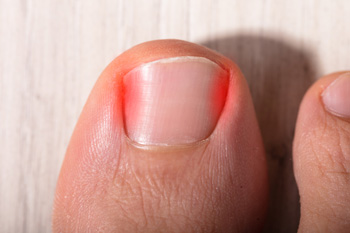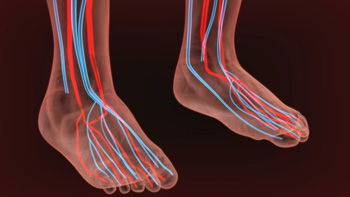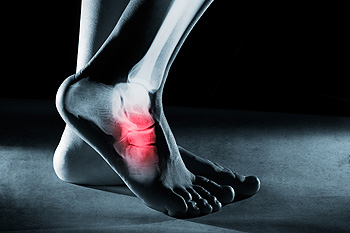June 2021
What Should I Do About My Ingrown Toenail?
 An ingrown toenail occurs when the edge of the nail grows into the surrounding skin rather than over it. This can make the surrounding skin red, tender, swollen, and painful. The nails on the big toes are frequently affected. If you notice an ingrown toenail on your foot, soaking the foot in warm, soapy water for 10 to 20 minutes three times per day and pushing the skin away from the nail bed may help within one or two weeks. Applying a corticosteroid cream to the area can reduce inflammation. Taking action to prevent future ingrown toenails is also important. You should always trim the toenails straight across and not too short using nail clippers. You should also avoid wearing tight or narrow shoes that crowd the toes. If home treatment does not improve your ingrown toenail, or if symptoms worsen, please seek the care of a podiatrist.
An ingrown toenail occurs when the edge of the nail grows into the surrounding skin rather than over it. This can make the surrounding skin red, tender, swollen, and painful. The nails on the big toes are frequently affected. If you notice an ingrown toenail on your foot, soaking the foot in warm, soapy water for 10 to 20 minutes three times per day and pushing the skin away from the nail bed may help within one or two weeks. Applying a corticosteroid cream to the area can reduce inflammation. Taking action to prevent future ingrown toenails is also important. You should always trim the toenails straight across and not too short using nail clippers. You should also avoid wearing tight or narrow shoes that crowd the toes. If home treatment does not improve your ingrown toenail, or if symptoms worsen, please seek the care of a podiatrist.
Ingrown toenails can become painful if they are not treated properly. For more information about ingrown toenails, contact Dr. Robert Graser of Graser Podiatry and Bunion Surgery Institute. Our doctor can provide the care you need to keep you pain-free and on your feet.
Ingrown Toenails
Ingrown toenails occur when a toenail grows sideways into the bed of the nail, causing pain, swelling, and possibly infection.
Causes
- Bacterial infections
- Improper nail cutting such as cutting it too short or not straight across
- Trauma to the toe, such as stubbing, which causes the nail to grow back irregularly
- Ill-fitting shoes that bunch the toes too close together
- Genetic predisposition
Prevention
Because ingrown toenails are not something found outside of shoe-wearing cultures, going barefoot as often as possible will decrease the likeliness of developing ingrown toenails. Wearing proper fitting shoes and using proper cutting techniques will also help decrease your risk of developing ingrown toenails.
Treatment
Ingrown toenails are a very treatable foot condition. In minor cases, soaking the affected area in salt or antibacterial soaps will not only help with the ingrown nail itself, but also help prevent any infections from occurring. In more severe cases, surgery is an option. In either case, speaking to your podiatrist about this condition will help you get a better understanding of specific treatment options that are right for you.
If you have any questions please feel free to contact our office located in Boerne, . We offer the newest diagnostic and treatment technologies for all your foot and ankle needs.
Is Foot Reconstruction an Option for Permanent Relief?
Foot reconstruction is a type of surgery that patients may opt for to correct the structure of the foot. People can be born with abnormal feet, or it can happen from an injury. Additionally, specific foot diseases can affect the overall health of the body, and reconstructing the foot may enhance a better quality of life. Metabolic diseases that can include diabetes or gout may affect foot function, and walking can be difficult. If you are suffering from feet that inhibit daily activities, it is strongly suggested that you consult with a podiatrist who can determine if this type of foot surgery is correct for you.
Foot surgery is sometimes necessary to treat a foot ailment. To learn more, contact Dr. Robert Graser of Graser Podiatry and Bunion Surgery Institute. Our doctor will assist you with all of your foot and ankle needs.
When Is Surgery Necessary?
Foot and ankle surgery is generally reserved for cases in which less invasive, conservative procedures have failed to alleviate the problem. Some of the cases in which surgery may be necessary include:
- Removing foot deformities like bunions and bone spurs
- Severe arthritis that has caused bone issues
- Cosmetic reconstruction
What Types of Surgery Are There?
The type of surgery you receive will depend on the nature of the problem you have. Some of the possible surgeries include:
- Bunionectomy for painful bunions
- Surgical fusion for realignment of bones
- Neuropathy decompression surgery to treat nerve damage
Benefits of Surgery
Although surgery is usually a last resort, it can provide more complete pain relief compared to non-surgical methods and may allow you to finally resume full activity.
Surgical techniques have also become increasingly sophisticated. Techniques like endoscopic surgery allow for smaller incisions and faster recovery times.
If you have any questions please feel free to contact our office located in Boerne, . We offer the newest diagnostic and treatment technologies for all your foot and ankle needs.
Why Does the Outside of My Foot Hurt?
The cuboid is a cube-shaped bone in the mid-foot, which forms a joint between the heel bone and the fourth and fifth metatarsal bones leading to the toes on the lateral (outside) part of the foot. When there is trauma or repetitive strain to surrounding soft tissues, the cuboid bone can become dislocated and block surrounding bones from normal movement. This condition is called cuboid syndrome. People with flat feet, athletes, and dancers are all more at risk of developing cuboid syndrome. Symptoms may include pain, swelling, tenderness, or redness on the outside of the foot, difficulty walking, and weakness in the foot. Cuboid syndrome can sometimes be mistaken for an ankle sprain. If you have pain on the outside of your foot and believe you may have cuboid syndrome, a visit to a podiatrist is suggested so that your foot can be examined and properly diagnosed. Cuboid syndrome treatment may include icing, bracing, taping, biomechanical control, rest, physical therapy, custom orthotics, or physical manipulation to guide the cuboid back into its normal position.
Cuboid syndrome, also known as cuboid subluxation, occurs when the joints and ligaments near the cuboid bone in the foot become torn. If you have cuboid syndrome, consult with Dr. Robert Graser from Graser Podiatry and Bunion Surgery Institute. Our doctor will assess your condition and provide you with quality foot and ankle treatment.
Cuboid syndrome is a common cause of lateral foot pain, which is pain on the outside of the foot. The condition may happen suddenly due to an ankle sprain, or it may develop slowly overtime from repetitive tension through the bone and surrounding structures.
Causes
The most common causes of cuboid syndrome include:
- Injury – The most common cause of this ailment is an ankle sprain.
- Repetitive Strain – Tension placed through the peroneus longus muscle from repetitive activities such as jumping and running may cause excessive traction on the bone causing it to sublux.
- Altered Foot Biomechanics – Most people suffering from cuboid subluxation have flat feet.
Symptoms
A common symptom of cuboid syndrome is pain along the outside of the foot which can be felt in the ankle and toes. This pain may create walking difficulties and may cause those with the condition to walk with a limp.
Diagnosis
Diagnosis of cuboid syndrome is often difficult, and it is often misdiagnosed. X-rays, MRIs and CT scans often fail to properly show the cuboid subluxation. Although there isn’t a specific test used to diagnose cuboid syndrome, your podiatrist will usually check if pain is felt while pressing firmly on the cuboid bone of your foot.
Treatment
Just as the range of causes varies widely, so do treatments. Some more common treatments are ice therapy, rest, exercise, taping, and orthotics.
If you have any questions, please feel free to contact our office located in Boerne, . We offer the newest diagnostic and treatment technologies for all your foot care needs.
Effective Methods That May Help Poor Circulation
 The condition that is known as poor circulation can have a negative effect on the feet. It can be caused by medical conditions that can include diabetes and high blood pressure, and many patients can experience numbness or a tingling sensation. Noticeable symptoms can consist of cold feet, hair loss on the legs and feet, and wounds may heal slower than usual. Effective prevention methods can include stopping smoking, and incorporating a gentle exercise routine into your daily regiment. Additionally, it is beneficial to consume a diet that is full of fruits and vegetables. If your feet have become numb, it is strongly suggested that you are under the care of a podiatrist who can help you to manage poor circulation.
The condition that is known as poor circulation can have a negative effect on the feet. It can be caused by medical conditions that can include diabetes and high blood pressure, and many patients can experience numbness or a tingling sensation. Noticeable symptoms can consist of cold feet, hair loss on the legs and feet, and wounds may heal slower than usual. Effective prevention methods can include stopping smoking, and incorporating a gentle exercise routine into your daily regiment. Additionally, it is beneficial to consume a diet that is full of fruits and vegetables. If your feet have become numb, it is strongly suggested that you are under the care of a podiatrist who can help you to manage poor circulation.
While poor circulation itself isn’t a condition; it is a symptom of another underlying health condition you may have. If you have any concerns with poor circulation in your feet contact Dr. Robert Graser of Graser Podiatry and Bunion Surgery Institute. Our doctor will treat your foot and ankle needs.
Poor Circulation in the Feet
Peripheral artery disease (PAD) can potentially lead to poor circulation in the lower extremities. PAD is a condition that causes the blood vessels and arteries to narrow. In a linked condition called atherosclerosis, the arteries stiffen up due to a buildup of plaque in the arteries and blood vessels. These two conditions can cause a decrease in the amount of blood that flows to your extremities, therefore resulting in pain.
Symptoms
Some of the most common symptoms of poor circulation are:
- Numbness
- Tingling
- Throbbing or stinging pain in limbs
- Pain
- Muscle Cramps
Treatment for poor circulation often depends on the underlying condition that causes it. Methods for treatment may include insulin for diabetes, special exercise programs, surgery for varicose veins, or compression socks for swollen legs.
As always, see a podiatrist as he or she will assist in finding a regimen that suits you. A podiatrist can also prescribe you any needed medication.
If you have any questions, please feel free to contact our office located in Boerne, . We offer the newest diagnostic and treatment technologies for all your foot care needs.
Blog Archives
- July 2024
- June 2024
- May 2024
- April 2024
- March 2024
- February 2024
- January 2024
- December 2023
- November 2023
- October 2023
- September 2023
- August 2023
- July 2023
- June 2023
- May 2023
- April 2023
- March 2023
- February 2023
- January 2023
- December 2022
- November 2022
- October 2022
- September 2022
- August 2022
- July 2022
- June 2022
- May 2022
- April 2022
- March 2022
- February 2022
- January 2022
- December 2021
- November 2021
- October 2021
- September 2021
- August 2021
- July 2021
- June 2021
- May 2021
- April 2021
- March 2021
- February 2021
- January 2021
- December 2020
- November 2020
- October 2020
- September 2020
- August 2020
- July 2020
- June 2020
- May 2020
- April 2020
- March 2020
- February 2020
- January 2020
- December 2019
- November 2019
- October 2019
- September 2019
- August 2019
- July 2019
- June 2019
- May 2019
- April 2019
- March 2019
- February 2019
- January 2019
- December 2018
- November 2018
- October 2018
- September 2018
- August 2018
- July 2018
- June 2018
- May 2018











